This page was written while I made my first measurements with this method. It is made available because it shows some of the difficulties and how they were detected.
S/N at room temperature is the same as the NF.
The definition of NF, noise figure, is that it is the loss of S/N compared to the S/N of a totally noise free receiver when listening to a signal that comes from a room temperature source (290 K).Linrad can be set to display S/N in the S-meter graph. By adding a scale shift one can arrange for the S-meter graph to show i.e. -0.64 dB for an amplifier with a known NF of 0.64 dB when a signal is sent into Linrad through a room temperature attenuator.
Linrad evaluates S at anarrow bandwidth which is always OK, but the noise is evaluated at the full bandwidth supplied by the hardware and that may cause errors.
As an example the amplifiers evaluated here: A study of several low noise amplifiers with Linrad-03.41 give S/N readings at 273K as listed in table 1.
Unit NF S/N at 273K S/N at 273K Diff (name) (dB) (dB) (dB-.2105) (dB) PSA4-5043 0.64 -0.4295 -0.64 0 MGF1425old 0.62 -0.0642 -0.2747 0.3453 MGF1801 0.31 0.0190 -0.1915 0.1185 MGF1425 0.28 0.0675 -0.1430 0.1370 ATF33143 0.24 0.0084 -0.2021 0.0379 2xAFT33143 0.24 -0.0373 -0.2478 -0.0078 ATF33143negimp 0.25 0.0652 -0.1453 0.1047Table 1.. The S/N value for a noise bandwidth of 1.8 MHz reflects the NF to within about 0.1 dB except for the MGF1425old amplifier which seems too good by 0.3 dB. That is because of the selectivity of this amplifier that reduces the effective noise bandwidth. | |||||||||||||||||||||||||||||||||||||||||||||||||||||||||||||||||||
Direct S/N measurements with the SDR-14.With total decimation of 700 the sampling rate is 95.237 kHz for a bandwidth of about 75 kHz. This is narrow enough for the amplifiers tested here.With a suitable preamplifier connected to the direct input a noise figure of 3 dB was obtained at 144 MHz as measured with a vacuum diode NF meter. That result is false however since the SDR-14 is not listening on 144 MHz only. Several aliases contribute. Without filters the S/N of a 144 MHz signal is 1.45 dB worse with the wideband amplifier PSA4-5043 with the ATF33143 which attenuates aliases to some extent (but not much.) For NF measurements one has to add a filter. Figure 1 shows the response for the filter used in the S/N measurements below. | |||||||||||||||||||||||||||||||||||||||||||||||||||||||||||||||||

| |||||||||||||||||||||||||||||||||||||||||||||||||||||||||||||||
| Fig. 1. This filter with 4 LC resonators eliminates aliases in the S/N measurements. | |||||||||||||||||||||||||||||||||||||||||||||||||||||||||||||
The filter is inserted between an RF amplifier (actually two cascaded amplifiers) and the SDR-14. Figure 2 shows a test of all the amplifiers listed in table 1 and table 2 lists the results from figure 1 as well as the S-meter reading for the signal with the different amplifiers. The S-meter graph is out of scale, but the coherent window shows S-meter values for the amplifier currently under test. In figure 2 the reading is 83.81 for the last test which is with the 2xATF33143 amplifier. | |||||||||||||||||||||||||||||||||||||||||||||||||||||||||||
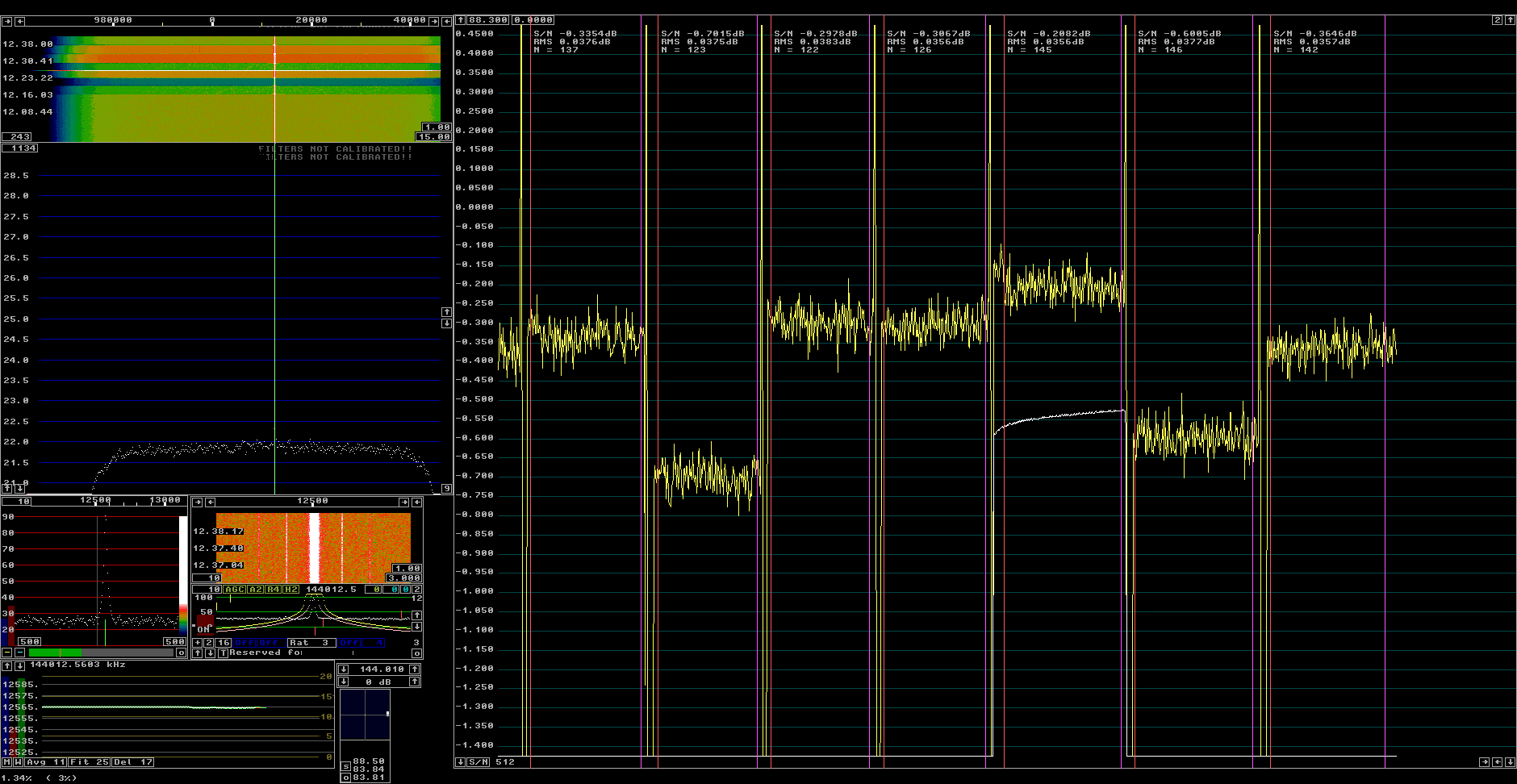
| |||||||||||||||||||||||||||||||||||||||||||||||||||||||||
| Fig. 2. This screen shows S/N for a signal that has passed through a room temperature attenuator. Seven different amplifiers were used, one after another. See text. | |||||||||||||||||||||||||||||||||||||||||||||||||||||||
1____2______________3___________4_________5______6__________7________8_______9____ No Unit NF S/N at 290K S Gain T2nd SysNF Diff (name) (dB) (dB) (dB) (dB) (°K) (dB) (dB) 1 MGF1801 0.31 -0.3354 82.75 28.25 0.63 0.32 -0.01 2 PSA4-5043 0.64 -0.7015 78.83 24.33 1.58 0.66 -0.04 3 MGF1425 0.28 -0.2978 82.85 28.35 0.62 0.29 -0.01 4 ATF33143 0.24 -0.3067 82.79 28.29 0.63 0.25 0.06 5 ATF33143negimp 0.25 -0.2082 87.76 33.26 0.20 0.25 0.04 6 MGF1425old 0.62 -0.6005 86.16 31.66 0.29 0.62 0.02 7 2xATF33143 0.24 -0.3646 83.81 29.31 0.50 0.25 -0.11 8 None 0.00 -3.94 54.50 0.00 428 3.94 0.00Table 2.. Evaluation of figure 2. Col. Explanation 1 Number in the time sequence in figure 2 2 Amplifier name. (None is a BNC to BNC female.) 3 NF as evaluated here. 4 S/N values from figure 2. 5 S-meter readings for each amplifier. 6 Amplifier gain (computed from column 5.) 7 Contribution to input noise from the test system. 8 System NF at the input of the tested amplifier. 9 Difference between system NF as measured by the two methods. | |||||||||||||||||||||||||||||||||||||||||||||||||||
|
The S/N values in column 4 are reasonably close to the expected noise figures. From that we can conclude that the NF of the test system is near 3.94 dB which corresponds to a temperature of 428 °K. By dividing 428 by the test object gain we get the contribution by the test system referenced to the input of the test object. That contribution is listed in column 7. By use of columns 1 and 7 we get the expected system NF at the input of the test object in each case. Those system noise figures should agree with the S/N values in figure 2, column 2 with reversed sign. Possibly with an offset. Column 9 shows the disagreement between the two methods. The measurements using an ice-water mixture and boiling water gives an absulute value for the NF. The method on this page just gives relative values. The value 88.300 in the upper left corner of the S-meter graph in figure 2 is an offset to the dB scale that gives a reasonable zero point. This value does of course depend on the signal level entering the test object and also on the noise bandwidth. It may also depend on various processing parameters. Tweaking low noise amplifiers.As illustrated above, Linrad can be used as a NF meter. It will display the system NF on the screen and the user would be responsible for taking the noise from subsequent amplifiers into account. By use of a low noise amplifier with high enough gain one can easily make the contribution from the second stage negligible as can be seen above.Figure 3 shows tweaking of the input LC resonator of an amplifier with a FHX05FA/LG. | |||||||||||||||||||||||||||||||||||||||||||||||||
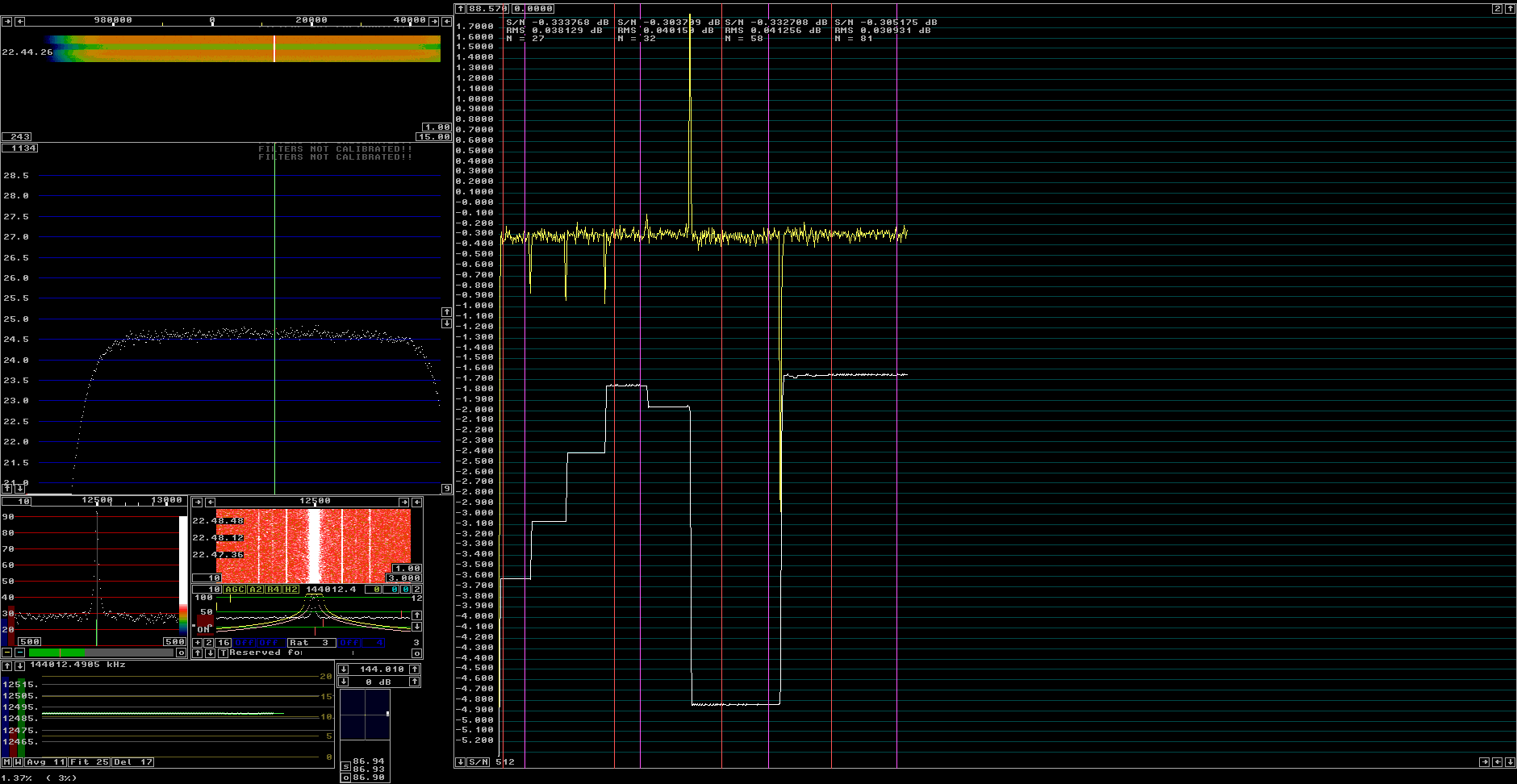
| |||||||||||||||||||||||||||||||||||||||||||||||
| Fig. 3. Here the input capacitor is tuned in steps of a half turn. The yellow curve shows the NF with an arbitrary offset and the white curve shows the amplifier gain. It is obvious that the lowest NF comes with the max gain tuning to which the amplifier is set after the stepped tuning. | |||||||||||||||||||||||||||||||||||||||||||||
In the same way the voltage, current and input coupling can be optimized. The FHX05FA/LG is my latest and best low noise amplifier with a NF somewhere around 0.17 dB. Long term stability with the SDR-14.The results presented above indicate an average uncertainty in the order of 0.05 dB as judged from table 2. That is well above what should be expected from the statistical uncertainty. To investigate the reasons for this uncertainty the system was left running for a long time. Figures 4 and 5 each show about 5 hours of recording the S/N graph. Figure 4 is during the night, ends at 6 in the morning. Figure 5 ends at noon. | |||||||||||||||||||||||||||||||||||||||||||

| |||||||||||||||||||||||||||||||||||||||||
| Fig. 4. About 5 hours ending at sunrise. | |||||||||||||||||||||||||||||||||||||||
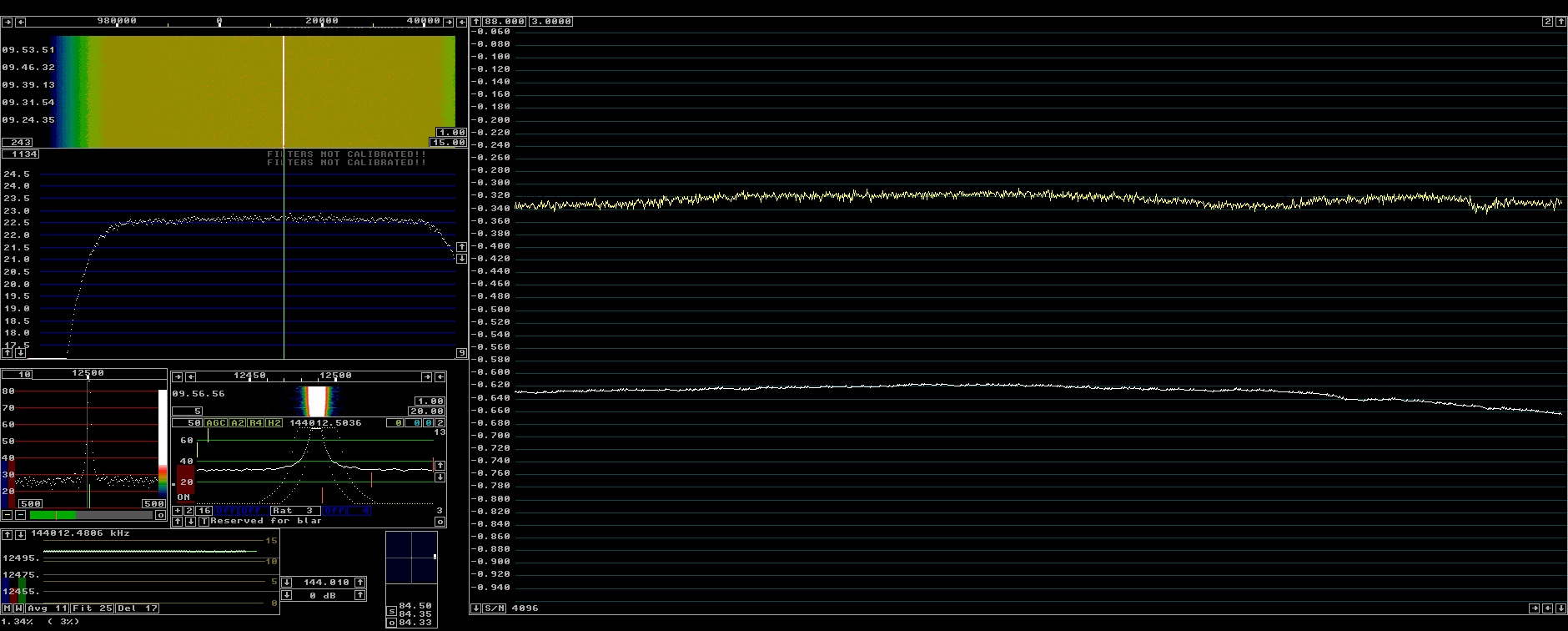
| |||||||||||||||||||||||||||||||||||
| Fig. 5. About 5 hours ending at noon. | |||||||||||||||||||||||||||||||||
It is clear from figures 4 and 5 that there is a stability problem with Linrad NF meter system. There are instabilities in the order of 0.02 dB. Both the signal level and the S/N vary with time in an irregular fashion that can not be attributed to random variation of the thermal noise floor. Temperature is always a threat to stability in measurements. Figure 6 shows a recording where this is investigated. | |||||||||||||||||||||||||||||||
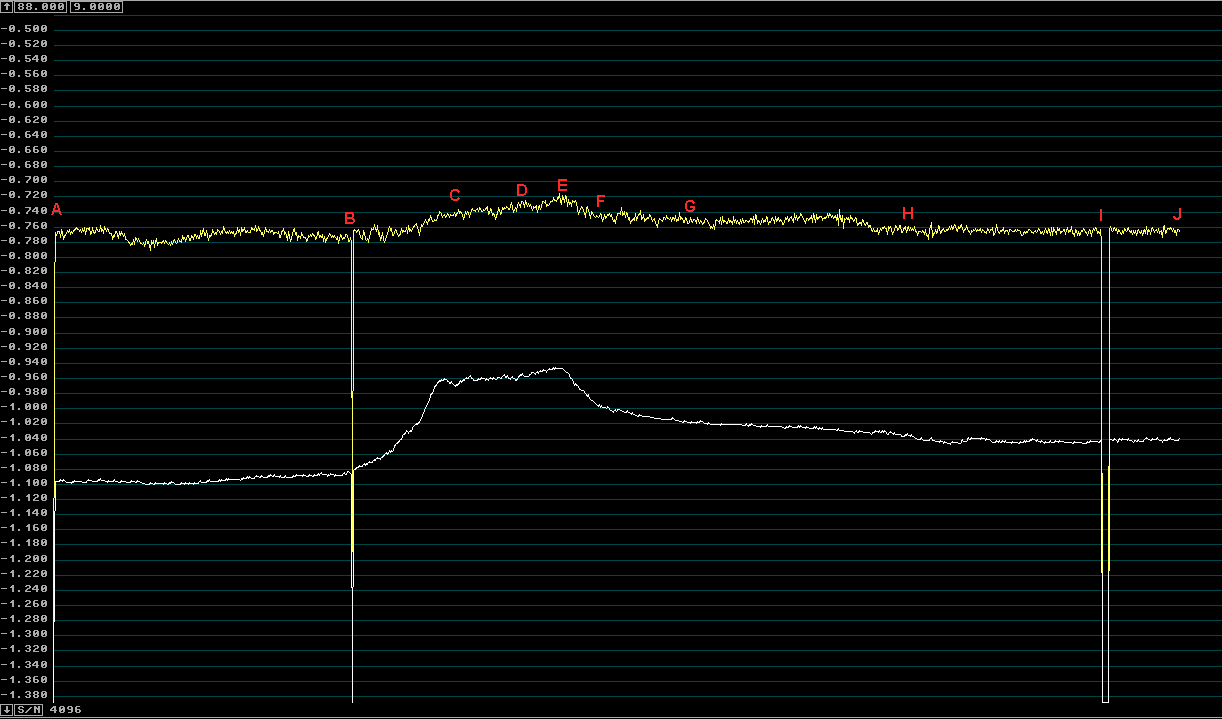
| |||||||||||||||||||||||||||||
Fig. 6. Variation with temperature and voltage.
Event Time Temp Voltage | |||||||||||||||||||||||||||
The experiment shown in figure 6 is with the attenuator at a constant temperature of 23 °C. A well isolated tank with water was used to achieve that. The experiment has two parts. First the windows were opened to cause the room temperature to drop by 6 °. Then the windows were closed again and finally the mains power to the signal generator was rised from 215 to 235 V. It is obvious that temperature is a problem but that variations in the mains voltage has no influence. There seems to be two different time dependencies. The signal generator seems to give a little more signal at lower temperatures. This is visible as an improvement of S/N. The gain of the receive system including the test object rises by about 0.15 dB for a temperature change of 6°. Long term stability with the SDR-IP.Figure 7 shows one hour with the SDR-IP. The test oscillator is the same HP8657A that was used in the previous experiments. It has been running for days and is well warmed up. The test signal is still at 144 MHz, but a SBL1 schottky mixer and another HP8657A at 134 MHz is used to shift the signal to 10 MHz where it is received by a SDR-IP. The attenuator is kept at 24 degrees in a water bath. It is quite clear that the stability is much better. Checking with the SDR-14 at 10 MHz reveals that the stability problems originate in the SDR-14.After about 45 minutes some ice was put into the water to bring the temperature down to 17 °C (=290°K.) | |||||||||||||||||||||||||

| |||||||||||||||||||||||
| Fig. 7. One hour running SDR-IP. The improved S/N at the end is because the temperature of the attenuator was changed from 24 °C to 17 °C. | |||||||||||||||||||||
With the improved stability using SDR-IP and switching several times between pairs of of amplifiers it should be possible to get a reliable second decimal on NF differences. Figure 8 shows the ATF33143 amplifier vs the FHX05FA/LG unit. | |||||||||||||||||||
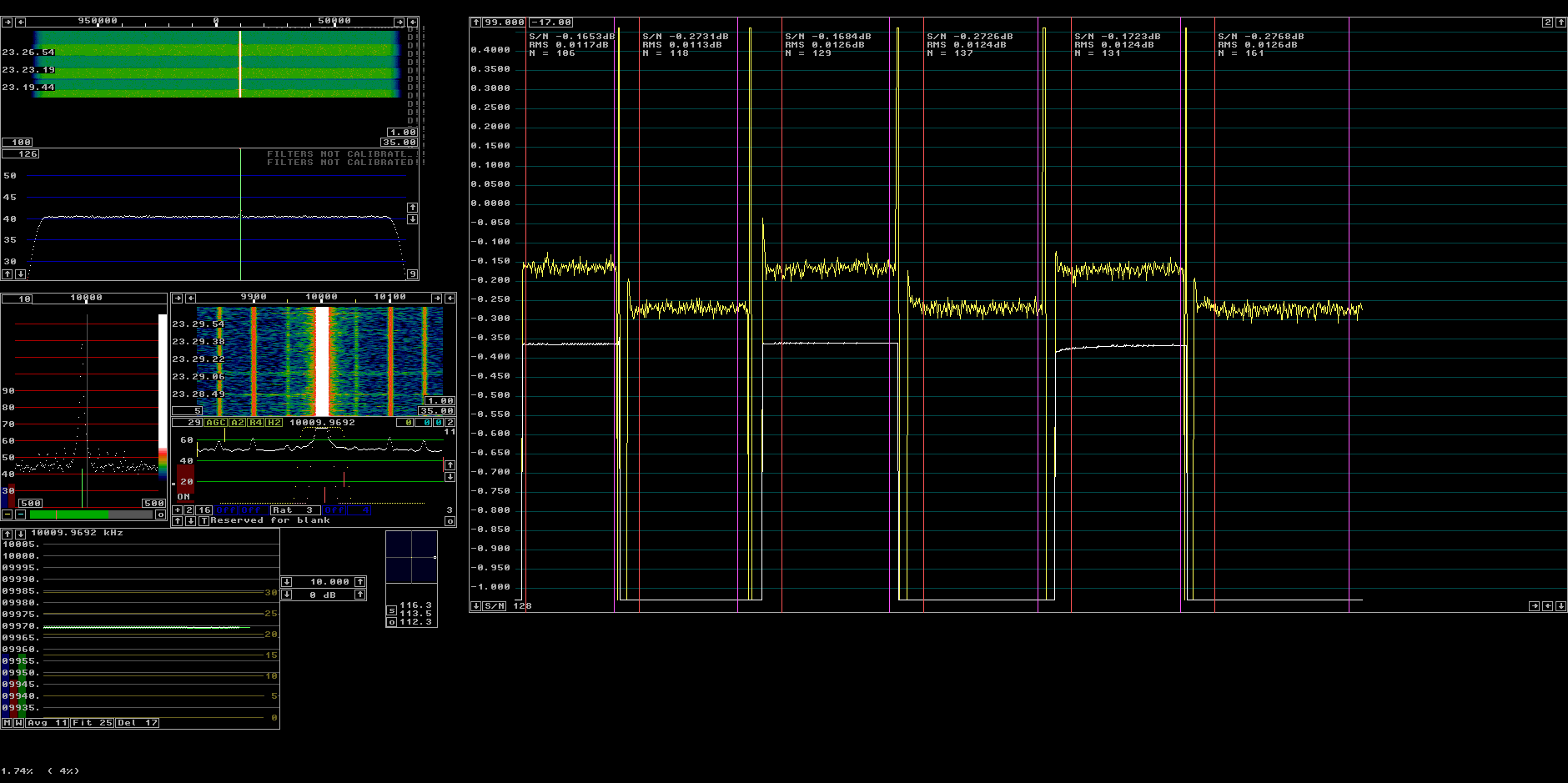
| |||||||||||||||||
| Fig. 8. Alternating between two test objects. The ATF33143 amplifier vs the FHX05FA/LG unit. The attenuator temperature is 290 °K. | |||||||||||||||
From figure 8 three differences can be obtained: 0.1078, 0.1042 0.1037 and the average is 0.105. Table 3 shows NF differences between pairs of amplifiers measured like figure 8. images are here. | |||||||||||||
FHX05FA/LG ATF33143negimp 2xATF33143 ATF33143 MGF1425 MGF1801 MGF1425old PSA4-5043
FHX05FA/LG 0.200 x - - x - x -
ATF33143negimp 0.005 0.205 - - - - - x
2xATF33143 - - 0.296 - - x - 0.000
MGF1425 - - - 0.305 - 0.000 - -
ATF33143 0.105 - - - 0.305 - - -
MGF1801 - - 0.034 0.025 - 0.330 0.001 -
MGF1425old 0.316 - - - - 0.185 0.516 -
PSA4-5043 - 0.444 0.353 - - - - 0.649
Table 3.. S/N differences between pairs of amplifiers.
| |||||||||||
|
In table 3 the lower part of the matrix contains measured S/N differences. The diagonal is S/N values computed from a guess that the S/N value for the FHX05FA/LG is 0.200. The upper half of the matrix has an x in the position from where the diagonal S/N value is computed. As a test three more amplifier pairs than necessary were measured. The discrepancy between those measurements and the values computed from the diagonal are displayed in the upper half of the matrix. The error of the S/N values in the diagonal seems to be below 0.001 dB. The system NF in these measurements was 3.5 dB. The correction for the contribution of subsequent stages is computed in table 4. | |||||||||
___1______________2_________3_______4________5_______6________7_______8____ Unit NF S/N Gain T2nd T Tcorr NF Diff (name) (dB) (dB) (dB) (°K) (°K) (°K) (dB) (dB) FHX05FA/LG ? -0.200 29.8 0.37 13.67 13.30 0.195 - ATF33143negimp 0.25 -0.205 33.26 0.17 14.02 13.85 0.203 0.047 2xATF33143 0.24 -0.296 29.31 0.42 20.45 20.03 0.290 -0.050 MGF1425 0.28 -0.305 28.35 0.52 21.10 20.58 0.298 -0.018 ATF33143 0.24 -0.305 28.29 0.53 21.10 20.57 0.298 -0.058 MGF1801 0.31 -0.330 28.25 0.53 22.89 22.36 0.323 -0.013 MGF1425old 0.62 -0.516 31.66 0.24 36.59 36.35 0.513 0.107 PSA4-5043 0.64 -0.649 24.33 1.32 46.74 45.42 0.632 0.008 None 0.00 -3.50 0.00 359 359 359Table 4.. Evaluation of table 3. Col. Explanation 1 Amplifier name. (None is a BNC to BNC female.) 2 NF as evaluated here. 3 S/N values from table 3. 4 Amplifier gain. 5 Contribution to input noise from the test system. 6 Noise temperature of amplifer assuming column 3 is the correct NF. 7 Corrected noise temperature. 8 NF of amplifier. | |||||||
|
It is clear from table 4 that the result for the MGF1425old amplifier does not agree with the hot/cold measurements. The discrepancy is far too large. Figure 9 shows what is the problem with the MGF1425old amplifier. | |||||

| |||
| Fig. 9. The MGF1425old amplifier is not well enough screened. Wrapping it in aluminium foil lowers the noise floor by about 0.03 dB. The error is small and becomes noticeable in the main waterfall only when a high gain is used for the colour scale. | |
The error due to inadequate screening depends strongly on how the test object is oriented. The computer is generating fairly strong local fields that may get into the test object depending on how it is oriented. Column 7 of table 4 is not the final result......... As can be seen in figure 8 there were sometimes horizontal traces in the baseband waterfall. They were traced to poor connectors. After adding some screws to the MGF1425old amplifier to improve screening a couple of cables with silvered center pins were replaced with cables having gold plated center pins. That eliminated the horizontal lines in the baseband waterfall. An attempt to reproduce table 4 failed completely. The first test showed that the ATF33143neginp was 0.1 dB better than the FHX05FA/LG. A test inserting a 0.25 wl cable indeed showed big variations in the NF. Something was very wrong and a check with the network analyzer showed that the impedance of the attenuator had changed from 50 ohms to 30 ohms. THERE WAS WATER INSIDE THE ATTENUATOR Making things watertight is difficult and I had failed. Heating the attenuator restored 50 ohms. Conclusions.I think this page demonstrates that we can tweak low noise amplifiers at room temperature provided that we can keep an attenuator at constant temperature. Y-factors are reliable down to well below 0.01 dB.The measurements at 30 ohms are accurate but of no interest. The FHX05FA/LG amplifier was tuned for 30 ohms and checking it at 50 ohms reveals that the ATF33143negimp amplifier is actually 0.015 dB better, not 0.005 dB worse as was the case at 30 ohms. |